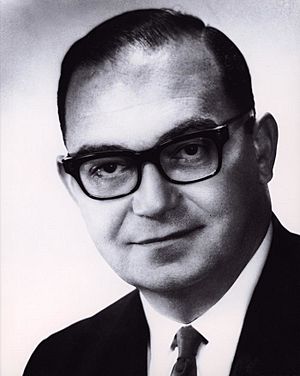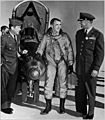Robert M. White facts for kids
Quick facts for kids
Robert M. White
|
|
|---|---|
 |
|
| Administrator of the National Oceanic and Atmospheric Administration | |
| In office 1970–1977 |
|
| Succeeded by | Richard M. Frank |
| Personal details | |
| Born | February 13, 1923 Boston, Massachusetts |
| Died | October 14, 2015 (aged 92) Chevy Chase, Maryland |
| Alma mater | Harvard University Massachusetts Institute of Technology |
| Occupation | Meteorologist |
Robert Mayer "Bob" White (born February 13, 1923 – died October 14, 2015) was an American meteorologist. A meteorologist is a scientist who studies the weather. He was the very first leader of the National Oceanic and Atmospheric Administration (NOAA). He led NOAA from 1970 to 1977.
White was born in Boston, Massachusetts. He also held many other important roles in science. He was the director of the United States Weather Bureau from 1963 to 1965. After that, he directed the Environmental Science Services Administration from 1965 to 1970. Later in his career, he was president of the University Corporation for Atmospheric Research from 1980 to 1983. He also led the National Academy of Engineering from 1983 to 1995.
Contents
A Leader in Weather and Ocean Science
Robert M. White played a big part in how the United States studies weather and oceans. He helped create NOAA. NOAA is a government agency that focuses on the Earth's oceans, major waterways, and atmosphere. It helps us understand and protect our planet.
His Important Roles
White started his career in weather science. He became the director of the U.S. Weather Bureau. This group was in charge of forecasting weather for the country. Later, he led the Environmental Science Services Administration. This agency brought together different science groups.
Founding NOAA
In 1970, many government science groups were combined. This created the National Oceanic and Atmospheric Administration, or NOAA. Robert White was chosen to be its first administrator. This was a very important job. He helped set up NOAA's goals and how it would work. Under his leadership, NOAA grew and became a key part of understanding Earth's environment.
Later Contributions
After leaving NOAA, White continued to work in science. He became president of the University Corporation for Atmospheric Research. This group helps universities study the atmosphere. He also led the National Academy of Engineering. This academy advises the nation on engineering and technology. His work helped advance science for many years.
Images for kids




